After a two-years hiatus Mars returns big and bright at opposition on October 13th, its best apparition until September 2035.
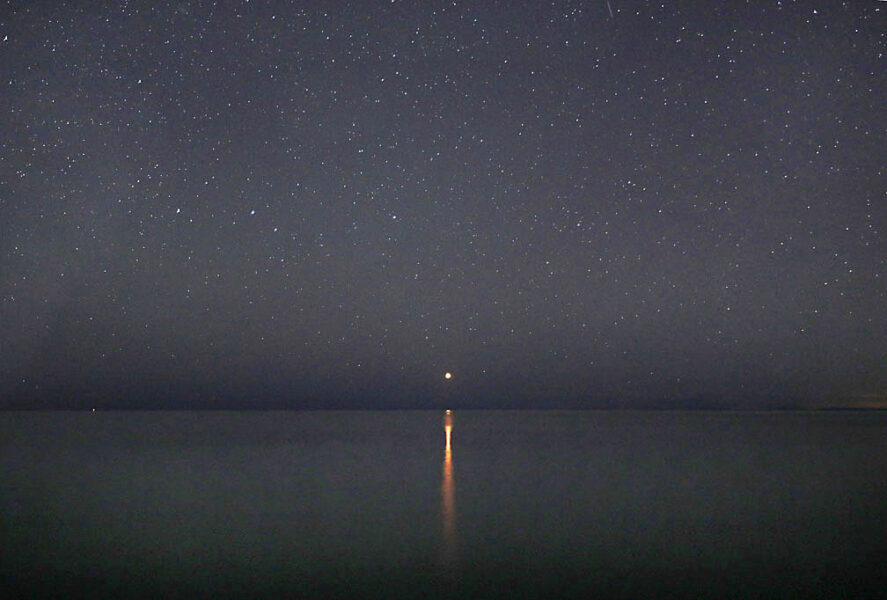
Bob King
Cosmic cycles have conspired to provide a series of seasonal spectacles during 2020 — spring's Venus apparition, Comet NEOWISE this summer, the reliable eyes of Jupiter and Saturn on summer and fall nights — and now the best Mars apparition until September 2035. Mars is at its closest to Earth today, October 6th, and at opposition on October 13th.
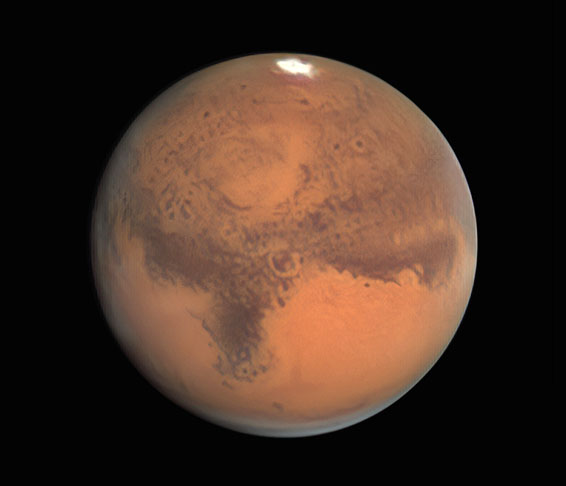
Damian Peach
Like you, I've watched with mounting excitement as the Red Planet has inched into the evening sky, growing ever larger and brighter. Views through the telescope the past few months have become increasingly more satisfying as the South Polar Cap (SPC) shrinks and familiar features like Syrtis Major and Sinus Meridiani become more prominent. One of the joys of telescopic Mars-gazing is following the planet's seasonal changes, which sometimes include nail-biting dust storms.
Best View of Mars
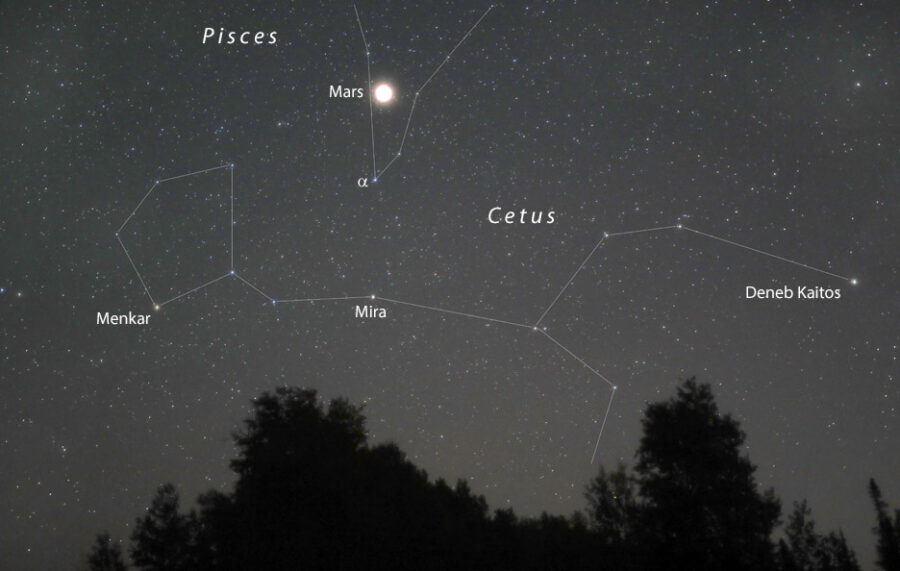
Bob King
Fortunately, no major dust storms have significantly obscured these or any other surface features to date. The 2018 perihelic apparition was a wash for many telescopic observers, maligned by a planet-encircling dust storm that kicked up just before opposition. Mars also spent the season low in the southern sky at declination –25° boiling away in poor seeing typical at low altitudes. Not this time around. The planet stands more than 30° higher in the sky than it did two years ago with an apparent diameter of 22.6″, just 1.8″ smaller than in 2018. The current apparition's about as perfect as it gets.

Socrates Linardos CC SA 4.0 International with additions by the author
On October 6th Mars and Earth will pull closest at just 62,070,492 kilometers (around 38.5 million miles) apart. Opposition occurs one week later on the 13th, but they'll be farther apart then — Mars reached perihelion in August and has been moving away from the Sun (and Earth) since. October 6th is a sweet spot or balance point between proximity to the Earth and increasing distance from the Sun.
What Side Are You Seeing?
Before you embark on your Martian journey it's helpful to know what side you're facing. Latitude and longitude specify the location of features on Mars just like they do on Earth. Use Sky & Telescope's Mars Profiler or NASA's Solar System Simulator to find out what part of Mars is centered in your direction.
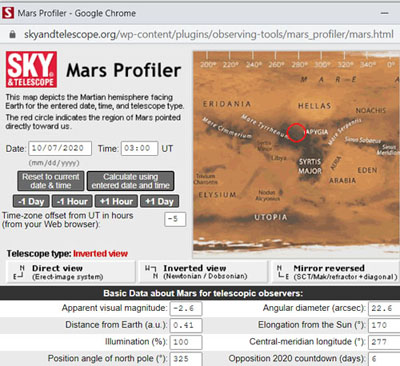
You can also download the free PC program Meridian which lists the longitude of the central meridian (CM) for for Mars and the four other classical planets. The CM is an imaginary line that runs from pole to pole across the center of the disk. Good views of a selected feature can be had for up to 4 hours centered on its CM passage.
One of my favorite aspects of observing Mars is watching the planet rotate "backwards" on successive nights. Mars rotates from (celestial) east to west like the other planets, but because it spins once every 24.6 hours — similar to but not quite matching Earth's period — surface features slowly drift 9.5° in longitude to the celestial east each night. So if Sinus Meridiani crosses the CM at 9 p.m. on a particular night, the next night at the same time it will appear 9.5° farther east. Going forward 41 days, it will cross the CM at 9 p.m. again.
Let's Explore Mars!
I find it to best to observe Mars at every opportunity to catch as may nights of good seeing as possible. Even a small 3-inch refractor at 75× will show the planet's pink-orange disk and hints of surface markings, also known as albedo features. One of the most arresting sights is the South Polar Cap (SPC). Because southern hemisphere summer began on September 3rd, already much of the frozen CO2 topping the SPC has sublimed away, exposing the permanent water ice cap to view. In October, it's narrowed and now requires 150× or more to see clearly.
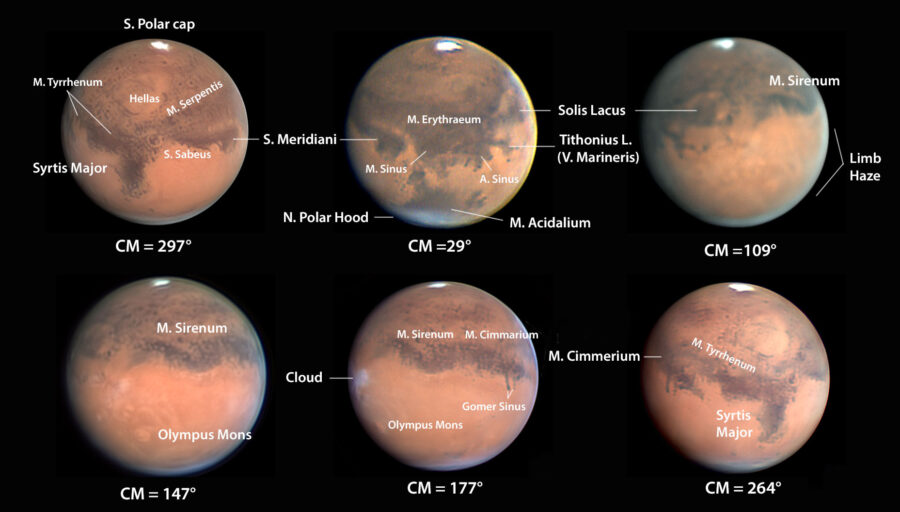
Damian Peach (top left, right); Mark Schmidt (top middle); Chris Go (bottom left); and Anthony Wesley (bottom middle and right)
Surface Smudges
At the opposite end of the Martian globe where it's winter, the North Polar Hood, an expansive cap of clouds shrouding the North Polar Cap (out of view), is now plainly visible as a bluish-white haze fringing the bottom limb of the planet.
Most of these features and the ones described below are visible through a 6-inch or larger telescope at moderate to high magnification (100× to 300×). The more often you observe Mars the easier they become to recognize. If mediocre seeing presents a challenge, apply a filter. A red Wratten 23A or 25 will give albedo markings a nice kick in contrast. For atmospherics like limb hazes and clouds try a blue Wratten 80A. Filters will also help tame the planet's glare and reduce eye fatigue. While dark surface features undergo changes in appearance due to scouring winds and seasonal dust deposition, their broad outlines have remained much the same for decades.

Click on the image for a larger version.
Damian Peach / Gregg Dinderman / S&T
The eastern hemisphere is dominated by thumb-shaped Syrtis Major and the twin, dark arcs of Mare Serpentis and Mare Tyrrhenum that branch off to either side and frame the Hellas impact basin. Moving west, look for the bright gap Hesperia that separates Mare Tyrrhenum from the dark ribbon of Mare Cimmerium. Under close inspection in excellent seeing you might catch a glimpse of Gomer Sinus, a pair of dark prongs poking out from the mare's eastern end.
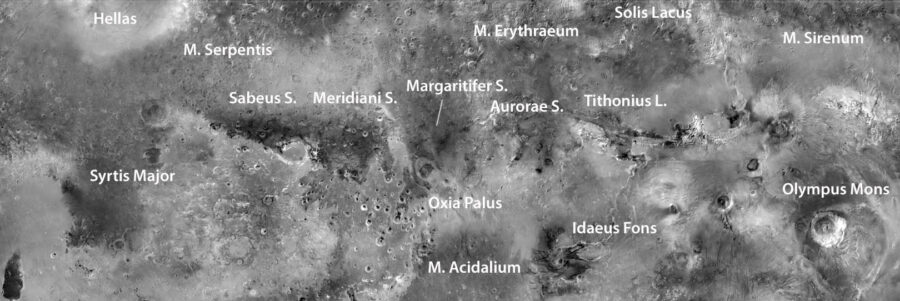
NASA, JPL, MSSS, Univ. of Arizona
West of Cimmerium we arrive at the planet's relatively featureless hemisphere, home to Mare Sirenum and the enormous and presently extinct volcano Olympus Mons. Under the best conditions with high magnification you might catch a glimpse of it when air moving past the mountain rises, cools, and condenses to form a mass of orographic clouds that increases its visibility. Look for a pale, white spot in the desert orange.
Mare Sirenum drops us off at Solis Lacus (Lake of the Sun), a grayish, circular patch framed by paler Thaumasia. Things get busy as we continue west starting with the dark and mottled Mare Erythraeum from which two "paws" extend: Aurorae Sinus and Margaritifer Sinus. The latter neatly blends with Oxia Palus to the north to create a paler version of Syrtis Major. In excellent seeing be sure to look for a narrow, dark projection extending due east of Aurorae Sinus. Dubbed Tithonius Lacus it's none other than part of the Valles Marineris, the largest canyon in the solar system.
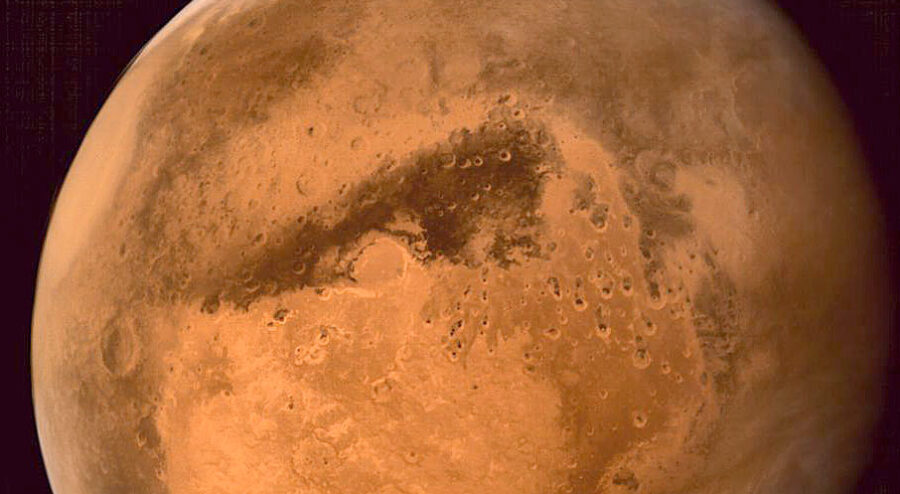
ISRO
North of the entire complex look for the dark block of Mare Acidalium and its two extensions: Niliacus Lacus to the northwest and Idaeus Fons to the northeast. Acidalium is easy to spot at 100×; higher power will help you pick out the other two.
We wrap up our planetary circle tour at the 0° meridian which gives its name to Sinus Meridiani, a prominent dark tennis ball at the end of Sinus Sabeus. Together they remind me of a ball launcher pet owners use in dog parks. Both stand out boldly against the bright desert terrain of Moab and Arabia.
See Mars: Atmosphere, Dust Storms, and Moons
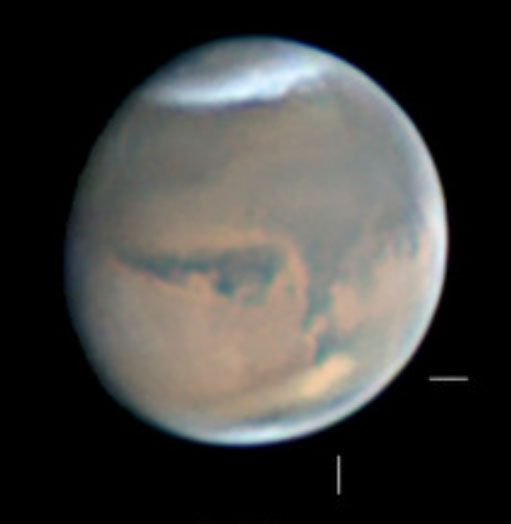
John Boudreau
Besides the SPC and NPH watch for limb hazes created by dust and dry ice crystals that scatter light high in the Martian atmosphere. Morning clouds form at the (celestial) east limb, evening clouds at the west limb. Since it's southern hemisphere summer keep an eye out for dust storms, too. Favored locales include Chryse, located between Margaritifer Sinus and Niliacus Lacus, and the region due south of Sinus Meridiani. If a feature that was apparent one night appears altered or "erased" the next time you look, suspect a storm. A yellow (Wratten #8) filter will enhance the view.
Every close opposition I seek out the planet's two tiny moons, Deimos and Phobos. This apparition they glow at magnitudes 11.8 and 10.7, respectively, and would be easy to see in smaller telescope were it not for the overwhelming brilliance of Mars. You can find them two ways: Keep Mars out of the field of view or hide the planet behind an occulting bar, a tinsel-width strip of aluminum taped inside your eyepiece. To make one, follow these instructions.
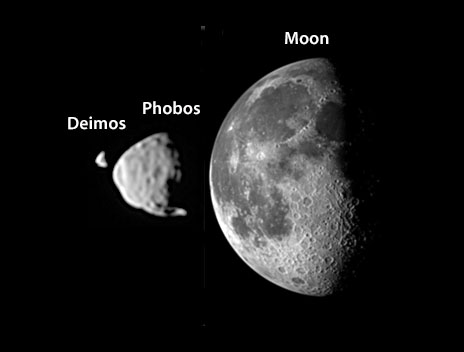
NASA, JPL-Caltech. Malin Space Science Systems, Texas A&M Univ.
While Deimos is fainter than Phobos it orbits farther from the planet, which makes it easier to see. During the current opposition , Deimos is about 67″ from Mars, while Phobos is just 20″. Most planetarium-style software programs such as Stellarium will show the moons' current positions, but you can also use the online Martian Moon Tracker.
Mars is the only planet in the solar system with readily visible surface features, so I encourage you to get intimately acquainted with this red orb fraught with possibility and change. Happy trails!
 9
9








Comments
Rod
October 6, 2020 at 1:27 pm
Nice job here Bob King. Last night I used my 90-mm Vixen (had since 1991) and enjoyed Mars at 200x. #23A Red filter made it easy to see Syrtis Major area and Hellas - stood out. #58 Green filter, the small south polar cap is brightened and easy to see. Weather looks good for me here tonight so I plan another observing run using my 10-inch Newtonian. I remember (stargazing log too) back in July-August 2018 opposition, Mars looked yellowish like a pumpkin because of the global dust storm. This opposition, Mars is looking great!
You must be logged in to post a comment.
Bob KingPost Author
October 8, 2020 at 9:06 am
Thanks, Rod. No pumpkins this time around — thank goodness!
You must be logged in to post a comment.
Rod
October 6, 2020 at 1:31 pm
FYI, the Sky Mars profiler tool works well. I also use Starry Night Pro Plus 8 simulation view and this shows a great detail too.
You must be logged in to post a comment.
Bob KingPost Author
October 8, 2020 at 9:08 am
Good to hear it, Rod. I've also found it to be accurate.The more tools the better.
You must be logged in to post a comment.
New Jersey Eclipse Fan
October 9, 2020 at 5:12 pm
Just wanted you both to know that I've been enjoying reading the articles and comments!
You must be logged in to post a comment.
Bob KingPost Author
October 12, 2020 at 6:09 pm
Thanks, NJEF! Much appreciated.
You must be logged in to post a comment.
Jprchri
October 9, 2020 at 6:02 pm
Love the Lake Superior photo! Do you remember the technical details?
You must be logged in to post a comment.
Bob KingPost Author
October 12, 2020 at 6:12 pm
Hi Jprchri,
I had to shoot at a fairly high ISO to record enough stars and make sure they didn't trail. I used a 35mm focal length, f/2.8 and ISO of (I believe) 6400 with an exposure of 5 seconds.
You must be logged in to post a comment.
Tom Hoffelder
October 13, 2020 at 10:00 pm
Hello Bob, excellent article; as I always tell people, Mars is the only planet you can look at and know you are looking at dirt! It is obviously not as spectacular as Jupiter or Saturn, but it is my favorite because of the dirt. I have been looking forward to this opposition because, as you noted, it is much higher in northern (New England in my case) skies than the previous two perihelic oppositions of 2003 and 2018. For those, the maximum altitude in my sky (Norway Maine) was 20 and 30 degrees; for this year, it is 50 degrees, a large difference for our always turbulent atmosphere. And the difference in size is not enough to affect the view. To view Mars at the size of the moon in 2003, 70X was required and in 2018 it was 75X. This year it is 80X, and as you know, it is not possible to tell the difference between any object at 70X compared to 80X. The five times that I have been able to view Mars this month has confirmed my theory. Also, as far as I can tell, this is the only Mars opposition that has both Jupiter and Saturn also in the sky in the past 50 years and at least the next 50, not to mention that Uranus and Neptune are also in the evening sky! Rare viewing days indeed! And as far as dust storms, I have an impression that dust storms are not unusual during perihelic oppositions. Since this one isn't, that was another reason I thought this year would be better.
You must be logged in to post a comment.
You must be logged in to post a comment.